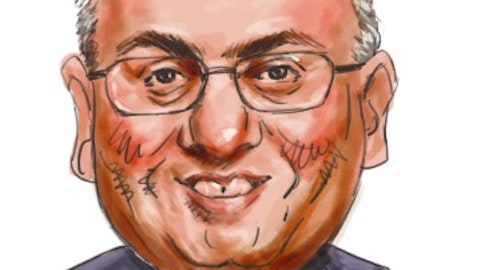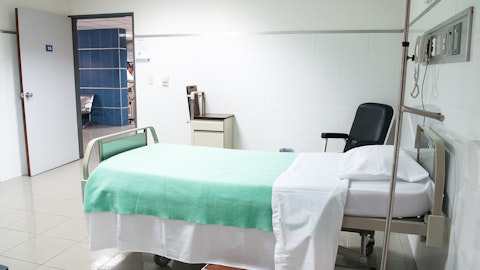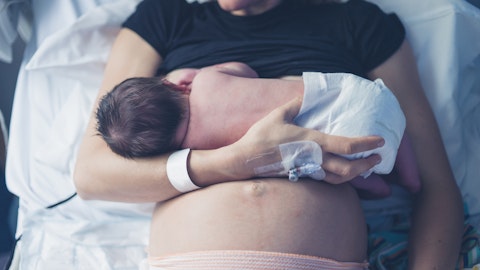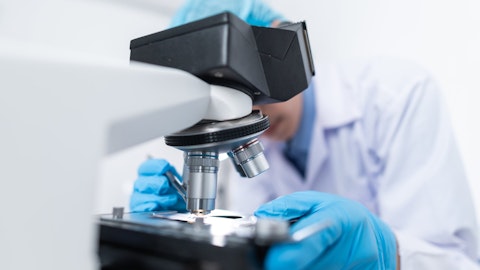Sarepta Therapeutics, Inc. (NASDAQ:SRPT) Q4 2022 Earnings Call Transcript February 28, 2023
Operator: Good afternoon and welcome to the Sarepta Therapeutics Fourth Quarter and Full Year 2022 Earnings Call. As a reminder, today’s conference call is being recorded. At this time, I will turn the call over to Mary Jenkins, Associate Director, Investor Relations. Please go ahead.
Mary Jenkins: Thank you, Valerie and thank you all for joining today’s call. Earlier this afternoon, we released our financial results for the fourth quarter and full year 2022. The press release is available on our website at sarepta.com and our 10-K was filed with the Securities and Exchange Commission this afternoon. Joining us on the call today are Doug Ingram, Ian Estepan, Dallan Murray and Dr. Louise Rodino-Klapac. After our formal remarks, we’ll open the call for Q&A. I’d like to note that during this call, we will be making a number of forward-looking statements. Please take a moment to review our slide on the webcast which contains our forward-looking statements. These forward-looking statements involve risks and uncertainties, many of which are beyond Sarepta’s control.
Actual results could materially differ from these forward-looking statements. And any such risks can materially and adversely affect the business, the results of operations and trading prices for Sarepta’s common stock. For a detailed description of applicable risks and uncertainties, we encourage you to review the company’s most recent annual report on Form 10-K filed with the SEC as well as the company’s other SEC filings. The company does not undertake any obligation to publicly update its forward-looking statements, including any financial projections provided today, based on subsequent events or circumstances. I’ll now turn the call over to President and CEO, Doug Ingram, who will provide an overview of our recent progress. Doug?
Doug Ingram: Thank you, Mary. Good afternoon, everybody and thank you for joining Sarepta Therapeutics for our fourth quarter and full year 2022 financial results conference call. 2023 may be the most eventful year in Sarepta’s event-filled history. Our Biologics License Application, or BLA, for our gene therapy SRP-9001 for Duchenne muscular dystrophy will be a significant bellwether moment: first, for the Duchenne families who are waiting without the luxury of patients for a therapy that might arrest the brutal decline associated with this disease; and next for the promise of gene therapy as a class to deliver meaningful improvements in the lives of patients with rare degenerative diseases, not at some distant vanishing points in the future but in time to do good now.
And given the keen interest in the 9001 BLA submission, I’m going to comment on the BLA review before I move to quarterly and yearly performance. As you will recall, in the fall of last year, we submitted our BLA for SRP-9001 to treat ambulant Duchenne patients. And in the fourth quarter, the FDA accepted the BLA for filing, granted 9001 priority review and set May 29, 2023, as our action date. We have been diligently prosecuting the BLA. We have by now completed a very productive mid-cycle review with the division. At the mid-cycle, the division requested additional CMC information and we have by now provided answers to all of those questions. The division formally informed us as well at the mid-cycle meeting that they see no significant safety issues that have been identified.
And the division has determined that there is no need for an advisory committee meeting for SRP-9001 BLA. As you may have read, FDA has announced that the Office of Tissues and Advanced Therapies, or OTAT, is being reorganized and a new super office entitled the Office of Therapeutic Products, or OTP, is being established. The goal is to improve alignment, increase resources and capacity and enhance expertise. A couple of thoughts. First, Sarepta is delighted by the establishment of OTP. We believe it will enhance reviews and serve Dr. Peter Mark’s publicly stated vision to lean in and accelerate the transformative potential of cell and gene therapy. Second, FDA has stated that the reorganization and establishment of OTP will not impact any time lines.
And we can confirm that we have not experienced any delay or disruption of any kind as a result of this reorganization. Indeed, we see the establishment of OTP as unequivocally positive and a potentially great benefit to patients. So going forward, we’re going to focus on the following: first, answering any remaining questions the FDA may have on the file; second, preparing for and managing preapproval inspections. The FDA has already scheduled 3 preapproval manufacturing inspections and along with our manufacturing partner, Catalent, we are preparing to make those inspections a success; third, building inventory for launch; and fourth, of course, completing our launch readiness. Now I provided an update on the mid-cycle today as there has been a significant amount of interest in whether the division would see the need for an advisory committee.
However, from here, we will be focusing on prosecuting the BLA and we’ll provide an update on or after the 9001 action date. Moving now to performance. As one ponders how Sarepta may execute the launch of 9001, if given that opportunity, I would ask you to consider the team’s consistent performance quarter-over-quarter and year-over-year, serving the Duchenne community with our 3 approved therapies: EXONDYS VYONDYS and AMONDYS. From an end-market perspective, 2022 was yet another year where our cross-functional team, including commercial, medical affairs, patient services, access and reimbursement and manufacturing and supply chain, to name a few, executed together and delivered for our patients. Fourth quarter total revenue stood at $258.4 million, while net product revenue came in at $235.9 million.
That is a 32% increase over the same quarter of the prior year. Full year total revenue came in at $933 million and net product revenue for the year came in at $843.8 million, representing a 38% year-over-year increase. For the last 5 years, we have grown at a consistent 40% compounded annual growth rate, all of which performance comes from serving the Duchenne community and none of which comes from price increases. Now as we announced at the JPMorgan conference in January, for 2023, our net product revenue guidance for our 3 currently approved PMO therapies, excluding the impact of a 9001 approval, is $925 million or greater. Moving back to SRP-9001 for a moment. We are commencing studies this year to ensure that we have the broadest label for SRP-9001 as is possible, consistent with the science.
We have already commenced our study to limit mutation-related exclusions. Further, in the coming months, we will be starting a study in the non-ambulant population called ENVISION or Study 303. And we will commence 2 separate studies with alternative approaches to removing preexisting antibodies to make SRP-9001 available to rh74 NAV-positive patients as well. Additionally, we are making significant progress with our limb-girdle pipeline as Dr. Louise Rodino-Klapac will discuss in a moment as she provides updates across our research and development activities. On the RNA platform, we will complete enrollment of the MOMENTUM study this quarter. MOMENTUM, as you know, is our study for our first next-generation peptide-conjugated PMO, also known as PPMO, next SRP-5051 designed to treat Duchenne patients who are exon 51 amenable.
MOMENTUM will read out later this year and if successful, we will discuss a filing for SRP-5051 with the neurology division this year. I am proud of the progress that we have made these last 6 years. And yet it pales in comparison to the good that we can do in the coming years together. We have the potential to improve the lives of countless patients and to greatly reward those who have been committed to and invested in this mission. Indeed, the opportunity in front of us is breathtaking. To realize that opportunity, we will need laser-focused and tenacious execution but as Sarepta has proven time and again, this is a team that knows how to execute. And with that, let me turn the call over to our Head of R&D and Chief Scientific Officer, Dr. Louise Rodino-Klapac.
Louise?
Louise Rodino-Klapac: Thanks, Doug. The accomplishments of 2022 and the opportunities before us in 2023 and beyond speak to the promise of science to fundamentally impact and change the lives of patients around the world. My deepest gratitude to our R&D colleagues across RNA, gene therapy and gene editing for their extraordinary work to get us where we are today. And where we are today represents an important moment in genetic medicine and an important moment for Sarepta. Firstly, we were thrilled to learn last November that the FDA accepted our BLA for review via the Accelerated Approval pathway for our lead gene therapy candidate, SRP-9001. This decision was based on our ability to show a robust expression of the SRP-9001 dystrophin protein, a shortened functional version of dystrophin serving as a surrogate endpoint reasonably likely to predict clinical benefit in patients with Duchenne muscular dystrophy.
Duchenne results from a mutation in the gene that codes for dystrophin. Dystrophin acts as a shock absorber in our muscle, attaching to the muscle membrane and distributing force as we move, thereby protecting our muscles from damage. Individuals with Duchenne lack dystrophin and as a result, their muscles become progressively worse. Our goal with SRP-9001 is to change the course of the fatal disease by treating the underlying cause of Duchenne with a onetime gene therapy that delivers functional dystrophin to the muscle. Based on well-established precedent, the FDA has approved 4 therapies to date using short and functional dystrophin as a surrogate endpoint. Further, Sarepta has generated the most compelling preclinical biomarker and clinical functional results to date.
What is particularly interesting about SRP-9001 but not completely surprising based on the strong scientific underpinning of our construct, is at the early SRP-9001 data provided read-through to our positive clinical experience with the therapy. Over the course of 10-plus years, I along with Dr. Jerry Mendell built researched and tested numerous constructs to determine what areas of the protein were functional and protective. We eventually identified an optimal gene cassette that will be able to retain protective and functional elements and fit easily into AAV, thereby enabling its delivery. This gene cassette was packaged into our AAV of choice, rh74 and we chose MHCK7 as our promoter. We are pleased with the early data which showed robust expression across skeletal, diaphragm and cardiac muscle.
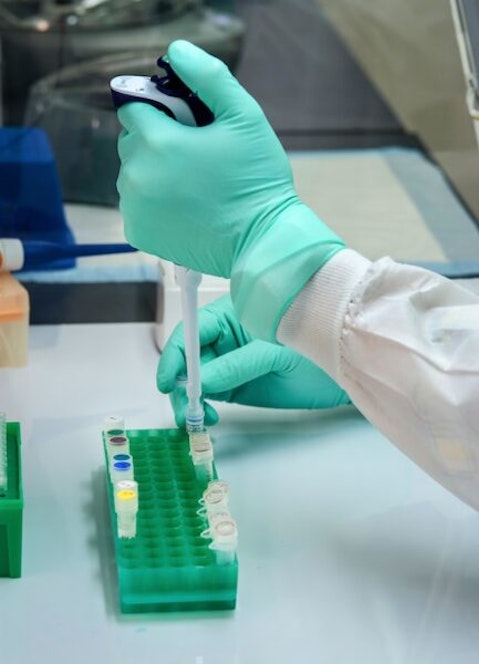
Photo by CDC on Unsplash
And as a result of that expression as well as the dystrophin protein demonstrating functional benefits, we saw significant restoration of function of the clinical target dose. To understand the significance of the results and their importance in the context of a viable therapy for Duchenne, it’s critical to understand the dystrophin-associated protein complex, or DAPC. DAPC is a collection of proteins to which dystrophin attaches. In it’s absence, these proteins disassemble. Individuals with Duchenne don’t have a functioning dystrophin-associated protein complex. Understanding this, when we inserted a functional dystrophin protein, we saw up-regulation of the DAPC in animal models. More specifically, we saw an almost 1-for-1 up-regulation of DAPC when there was expression of the SRP-9001 dystrophin, confirming the protective properties of the protein.
Further, we saw significant reduction increase in kinase or CK levels. CK is an enzyme associated with muscle damage. The reduction in CK provided further proof that SRP-9001 was reasonably likely to predict clinical benefit. The strength of this early work gave us the confidence and conviction to advance SRP-9001 into the clinic. Since 2018 and across multiple studies, we’ve dosed over 140 patients, more than any other gene therapy being developed for Duchenne and the clinical results have surpassed our expectations. SRP-9001 demonstrated robust expression of dystrophin far above what literature would suggest is necessary to be protective of muscle. All of it is properly localized at the muscle membrane or sarcolemma where it acts as a shock absorber.
We also developed a cell-based potency assay that shows that SRP-9001 is active, functional and protective at the muscle membrane. And as in the animal models with robust expression of SRP-9001, we saw significant reduction in CK. Finally, expression of SRP-9001 in patients leads to up-regulation of the DAPC. In addition to all of this compelling evidence, we are also able to show functional benefit versus what natural history would predict. NSAA, or the North Star Ambulatory Assessment, is our primary functional endpoint. We were able to show benefit across 1-, 2- and 4-year time points. In summary, based on the totality of the data, we were able to provide objective evidence that SRP-9001 qualifies as a disease-modifying agent and at the levels of dystrophin expressed based on vast clinical evidence and experience are reasonably likely to predict clinical benefit in patients with Duchenne.
As Doug mentioned in his opening comments, since the agency is not planning on holding an advisory committee for SRP-9001, the team is focused on responding to any remaining requests. As a reminder and because we are in active review with the FDA, we do not anticipate publicly sharing additional data cuts from the SRP-9001 studies leading up to the 2023 regulatory milestones and the EMBARK data readout which is on track for the fourth quarter of this year. Continuing now with our gene therapy platform and our limb-girdle muscular dystrophy programs. We were pleased to announce earlier this month the first patient was dosed in study SRP-9003-102, also known as VOYAGENE. VOYAGENE is a Phase I study evaluating SRP-9003 for the treatment of limb-girdle muscular dystrophy type 2E in ambulant adult patients and non-ambulant patients using clinical process SRP-9003 material.
Combined with positive expression and functional data shared from our initial study, SRP-9003-101, we believe the data from VOYAGENE will give us insights into a broader patient population as we finalize plans for a global Phase III study using commercially representative process material that we intend to begin later this year. In addition, we plan to commence a systemic pilot study for our SRP-604 — 6004 dual-vector rh74-mediated gene therapy to treat LGMD2E characterized by the absence of the protein dysperlin. We believe our gene therapy platform is well suited to generate medicines for the limb-girdle muscular dystrophies. Our work in this area continues on pace and represents a key priority for Sarepta. Turning now to our RNA platform.
MOMENTUM study for our next-generation PPMO, SRP-5051, is ongoing and we remain on track to announce data toward the back half of 2023. Further, we were pleased to complete enrollment in the ESSENCE trial, our post-marketing requirement for golodirsen and casimersen. And lastly, we are making good progress with our MIS51ON study and it continues on pace. In closing, I want to take a moment to recognize Rare Disease Day and the over 300 million individuals around the world living with a rare disease. This is my life’s work and I along with my colleagues at Sarepta will not rest until we do our part in advancing the science and developing the therapies for waiting patients. I would also like to say thank you to the patients and their families whose generously gift of their time and commitment to our trials.
We could not undertake this important work without you. I will now turn the call over to Dallan for an update on our commercial activities. Dallan?
Dallan Murray: Thank you, Louise and good afternoon. In 2022, the team delivered yet another year of strong double-digit growth across all 3 of our RNA-based PMO therapies. As Doug noted, our full year net product revenue was $843.8 million which beat the upper end of our upwardly revised 2022 guidance of $825 million to $840 million. This represented more than $230 million in growth over 2021 and a growth rate that approached 40% year-over-year. I’ll take a moment to highlight some of our full year 2022 achievements for our PMO franchise. The team started the year in a strong position by successfully navigating the beginning of the year insurance changes and reauthorizations. This led to a reauthorization rate in the low to mid-90s throughout 2022.
This robust start, coupled with continued high adherence rates and strong ex U.S. revenues, served as the foundation for full year net product revenue growth of approximately 13% generated with EXONDYS 51 and net product revenue of roughly $511 million. For VYONDYS 53, we ended 2022 in a strong leadership position and market share. VYONDYS 53 exceeded $100 million in revenues, ending the year with $117.4 million in total net product revenue and over 30% growth compared to 2021. And last but not least, the team’s continued execution on AMONDYS 45 produced exceptional growth in 2022 of over 200% with total net product revenue of $214.8 million. As we’ve noted in previous calls, our ex U.S. growth continues to accelerate and represented roughly 11% of our overall net product revenues in 2022.
Ex U.S. net product revenue was $96.3 million for the full year of 2022. Our performance in 2022 is the result of a highly committed and effective team focused on serving the nearly 30% of patients on metal wire therapies with the level of urgency that Duchenne requires. Turning now to our performance in the fourth quarter of 2022. We ended the year on a high note with net product revenues of $235.9 million. Once again, the team executed and grew the RNA-based PMO business by more than 30% over the fourth quarter of 2021 and 13% over the prior quarter. I’ll now outline individual net product revenues for the fourth quarter of 2022 for our 3 approved RNA-based PMO therapies. For EXONDYS 51, net product revenue of $146 million represented roughly 22% growth over Q4 of ’21.
VYONDYS 53 fourth quarter 2022 net product revenue totaled $28.5 million, representing roughly 15% growth versus the fourth quarter of 2021. And finally, AMONDYS 45 net product revenue was $61.4 million in Q4 of 2022, representing nearly 80% growth versus the fourth quarter of 2021. As the business evolved and grew throughout 2022, we see more variability in our quarter-over-quarter revenue numbers due mainly to ex U.S. ordering patterns. We have observed lumpy quarter-to-quarter fluctuations and seasonality with our ex U.S. orders. We expect this trend to continue going forward. For example, sales in the fourth quarter of 2022 were robust due to very strong ex U.S. sales of $36.9 million. This strength allowed us to far exceed expectations for the quarter.
However, we do not expect the same dynamic to persist into the first quarter of 2023. We want to provide you this level of visibility to help you model our revenues for the year. Our forecast anticipates this dynamic and it is reflected in our 2023 PMO net product revenue guidance of greater than $925 million which we issued in January. Despite the quarterly fluctuations, overall, we expect a strong year and are confident in our guidance. Again, I’m proud of what we accomplished in 2022. And most importantly, I’m grateful for our team’s enduring commitment to the Duchenne community and the patients we serve. This commitment to operational excellence will serve us in the patient community well as we apply the lessons learned to the upcoming launch of SRP-9001.
In parallel with the team’s execution of our existing business in 2022, the customer organization build for SRP-9001 is on track and nearly complete. Importantly, engagement with key gene therapy sites and U.S. payers is well underway. If SRP-9001 is approved, the team is once again prepared to demonstrate their capabilities and hard-fought expertise in our fourth launch into the Duchenne space with the first gene therapy to serve the patient community. And now I’ll turn the call over to Ian Estepan for an update on our financials. Ian?
Ian Estepan: Thanks, Dallan. Good afternoon all. This afternoon’s financial results press release provided details for the fourth quarter and full year of 2022 on a non-GAAP basis as well as a GAAP basis. Please refer to the press release available on Sarepta’s website for a full reconciliation of GAAP to non-GAAP financial results. For the 3 months ended December 31, 2022, the company recorded total revenues of $258.4 million which consists primarily of net product revenues and collaboration revenues compared to revenues of $201.5 million for the same period of 2021, an increase of $56.9 million. Net product revenue for the fourth quarter of 2022 from our PMO exon skipping franchise was $235.9 million compared to $178.7 million for the same period of 2021.
The increase in net product revenue primarily reflects increasing demand for our products. For the quarters ended December 31, 2022 and 2021, we recognized $22.5 million and $22.7 million of collaboration and other revenues, respectively which primarily relates to our collaboration arrangement with Roche. The reimbursable co-development costs under the Roche agreement totaled $51.7 million for the fourth quarter of 2022 compared to $29.7 million for the same period of 2021. On a GAAP basis, we reported a net loss of $109.2 million or $1.24 and $122 million or $1.42 per basic and diluted share for the fourth quarter of 2022 and 2021, respectively. We reported a non-GAAP net loss of $46.5 million or $0.53 per basic and diluted share in the fourth quarter of 2022 compared to a non-GAAP net loss of $66 million or $0.77 per basic and diluted share in the fourth quarter of 2021.
In the fourth quarter of 2022, we recorded approximately $30.8 million in cost of sales compared to $31.7 million in the same period of 2021. The decrease in cost of sales is primarily due to write-off of certain batches of our products not meeting the quality specifications for the 3 months ended December 31, 2021, with no similar activity in the same period of 2022 and a decrease in our royalty payments during the 3 months ended December 31, 2022, due to changes in our BioMarin royalty terms. On a GAAP basis, we recorded $213.8 million and $197.3 million in R&D expenses for the fourth quarter of 2022 and 2021, respectively, a year-over-year increase of $16.5 million. The increase is primarily due to increases in upfront and milestone expenses.
On a non-GAAP basis, R&D expenses were $186.8 million for the fourth quarter of 2022 compared to $175.5 million for the same period of 2021, an increase of $11.3 million. Now turning to SG&A. On a GAAP basis, we recorded approximately $120.5 million and $78.1 million of expenses for the fourth quarters of 2022 and 2021, respectively, an increase of $42.4 million. The increase was driven primarily by an increase in stock-based compensation expense primarily due to additional expense recognized through the CEO grant modification agreement executed in 2022. On a non-GAAP basis, the SG&A expenses were $86.6 million for the fourth quarter of 2022 compared to $60.1 million for the same period of 2021, an increase of $26.5 million. On a GAAP basis, we recorded $5.5 million in other income net for the fourth quarter of 2022 compared to $16.1 million in other expense net for the same period of 2021.
The change is primarily due to an increase in interest income due to the investment mix of our investment portfolio as well as the reduction of interest expense incurred as a result of the repayment of our December 2019 term loan for the 3 months ended December 31, 2022. We expect that both SG&A and R&D expenses will be higher in 2023 as we build inventory and prepare for the launch of SRP-9001. The increases in expenses will however be partially offset by the growth in our revenue. We had approximately $2 billion in cash, cash equivalents and long-term restricted cash at December 31. And we’ve made tremendous progress over the course of 2022 and this upcoming year has the potential to dwarf all that we have previously accomplished. I’m particularly pleased that we are well capitalized to execute on all of our plans that we’ve outlined today on the call.
And with that, I’ll turn the call back over to Doug for Q&A. Doug?
Doug Ingram: Thank you very much, Ian. Valerie, let’s open up the lines for questions and answers.
See also Billionaire Ken Fisher’s New Purchases and 25 Most Profitable Companies in the World.
Q&A Session
Follow Sarepta Therapeutics Inc. (NASDAQ:SRPT)
Follow Sarepta Therapeutics Inc. (NASDAQ:SRPT)
Operator: Our first question comes from the line of Anupam Rama of JPMorgan.
Anupam Rama: Congrats on all the progress. I noticed in the press release and Doug, in your comments as well that the FDA noted no major safety concerns in the filing for 9001. Was there any commentary on the mid-cycle review on the external control arm and that analysis? If I remember correctly that, that was a prespecified analysis by the FDA? And then quickly on manufacturing. Doug, in your opening comments, did you say that the site inspections have been scheduled?
Doug Ingram: Yes. Thank you very much for your questions, Anupam. So first, as you noted, on safety, the — at the mid-cycle review of the division explicitly in writing informed us that they saw no — they see no significant safety issues with the filing with 9001. That would — that should come as a little surprise, I suppose, to those who know our profile but it was, to say the least, gratifying and encouraging that the FDA saw it the way we saw it. As — I’m not going to get into a lot of detail on the review beyond what I’ve already said. I will say on the clinical side of things, we’re in an active review. As you know, there are lots of questions and analyses that we’ve done and questions we’ve answered. I can at least say at the mid-cycle review, the division did not identify any significant issues or material deficiencies with the clinical data set at all.
So that’s where we are as of the mid-cycle. And then finally, as it relates to the site inspections, yes, all of the manufacturing inspections have been scheduled.
Operator: Our next question comes from the line of Brian Abrahams of RBC.
Brian Abrahams: Congrats on all the progress. Is there anything more you can say, at least more broadly, on the nature of the CMC dialogue in preparation for the manufacturing inspections? And I guess I’m curious, your level of manufacturing confidence and overall comfort that there’d be sufficient time post these inspections to rectify any minor issues that might come up and still have sufficient time to build supply. And then just maybe quickly, I’m wondering also if the FDA provided any specific reasons as to why no Adcom would be required. I know sometimes they give specifics on that.
Doug Ingram: Yes. Thank you very much for that, Brian. First on CMC, there — I think as everyone knows and certainly we’ve talked about before with respect to BLAs and I think, in particular, with gene therapy, the CMC part of the submission in the Q&A is some of the most significant ones. As I mentioned before, as it relates to all of the questions that the agencies had, we were current and have answered all of their questions. So we feel like we’re in very good shape there. We feel like we’re in very good shape with those questions. As it relates to the timing of the preapproval inspections themselves, yes, we’re very, very confident in the timing. So we — I’m not going to go into detail on the schedules but we’re confident about the schedules and the timing and the ability to adapt ourselves.
We don’t, as we sit here today, have any reason to believe that there would be a delay in our PDUFA date for this or any other reason right now, at least as of now. And then as it relates to the decision that there wasn’t a need for an advisory committee, there really isn’t any additional color other than we had the mid-cycle. They confirmed they saw no safety issues — significant safety issues with the program. They didn’t identify any significant clinical issues or major deficiencies and then determine that they didn’t need an Adcom. That’s where we are right now.
Operator: Our next question comes from the line of Colin Bristow of UBS.

